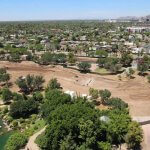Business Real Estate Weekly of Arizona is reporting a loan on Park Central is currently in default, and the property is scheduled for a trustee’s sale on April 19. Read the full story here.
Park Central has played a key role in this community’s development and the potential change of ownership of this prime Midtown property could set the stage for a renewed interest in the Central Corridor.
Upon hearing the news, DPJ asked its colleagues what they thought the potential change might mean.
“In residential terms, the Park Central site is one of the strongest potential development plays in Midtown,” David Newcombe, realtor for Russ Lyon Sotheby’s International Realty, who represented the nearby One Lexington condominiums. “With the right mixed-use elements included it could be game-changer for the Central Corridor.”
“You can’t talk about Park Central development without mentioning METRO Light Rail, and how it has changed people’s view of Central Avenue in recent years,” said Don Keuth, Phoenix Community Alliance President. “Will there be an opportunity to capitalize on that asset by developing a dense, multi-use project more appropriate for an urban setting? We’ll have to see how it shakes out.”
Park Central was billed as Phoenix’s first “modern” shopping mall and has been more recently viewed as the impetus of Phoenix’s propensity for sprawling development. As mentioned by Phoenix residents J. Seth Anderson, Suad Mahmuljin, and Jim McPherson in their recently published book, Downtown Phoenix, (Arcadia Publishing, 2012):
“In 1957, Phoenix’s first shopping mall, Park Central Shopping Center, opened along North Central Avenue between Thomas and Osborn Roads, enticing downtown retail fixtures to move – Goldwater’s, then Diamond’s, then J.C. Penny’s.
In the 1960s, all of the major department stores fled downtown and empty storefronts replaced bustling activity. Where the action (and corporate investment) took place was midtown and uptown Phoenix in the first wave of high-rise development, exemplified by the construction of the Phoenix Corporate Tower in 1960 (replacing the Westward Ho as the city’s tallest building), the Executive Towers Condominiums in 1963, and 4000 North Central Avenue in 1964.” (Downtown Phoenix, page 95.)
[Note: Phoenix Community Alliance partners with Urban Affair, publisher of Downtown Phoenix Journal. David Newcombe partnered in the development of DPJ’s Live Here section. J. Seth Anderson writes for DPJ. Jim McPherson is a sponsor of DPJ’s Engage Page. All are knowledgeable and trusted voices of Downtown Phoenix.]






